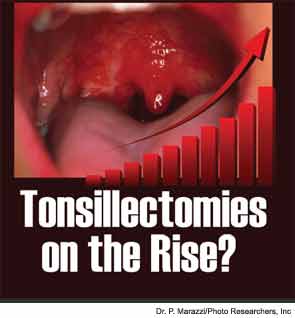
Explore This Issue
November 2012Are tonsillectomies on the rise? It’s a question that otolaryngologists have pondered in the wake of a recent article published in the Journal of Pediatrics that showed geographic and socioeconomic variation in the number of tonsillectomies performed (J Pediatr. 2012;160(5):814-819).
Over the years, indications for the 3,000-year-old procedure have shifted and tracking methods have evolved, and, as a result, any change in the rate of tonsillectomy should be viewed in light of these variables. Additionally, “individual provider decisions and patient needs will cause some variation in care across the United States,” with children covered under privately funded insurance perhaps more likely to undergo the procedure than their counterparts on Medicaid, said Emily F. Boss, MD, MPH, the article’s lead author and an assistant professor in the pediatric otolaryngology division at The Johns Hopkins University School of Medicine in Baltimore. Meanwhile, “tonsillectomy in the outpatient setting has definitely increased,” she said.
The study shows the marked patient and geographic variation in the use of tonsillectomies, said David Goodman, MD, MS, professor of pediatrics at The Dartmouth Institute for Health Policy and Clinical Practice at Geisel School of Medicine at Dartmouth in Hanover, N.H. “Previous studies show that a substantial proportion of regional variation reflects differences in provider practice patterns not explained by patient needs or preferences. This problem is compounded by the slow pace of clinical research,” he said. “Seventy-five years after Glover published his seminal study of tonsillectomy in school aged-children in England, we still have insufficient information on the short- and long-term outcomes of the medical and surgical therapies” (Pro Royal Soc Med. 1938;31:95-112).
Further, analyzing the statistics is complicated. The tracking methodology may account for at least some of the apparent increase in tonsillectomy, said Craig Derkay, MD, FACS, FAAP, professor and vice chairman of otolaryngology at Eastern Virginia Medical School and director of pediatric otolaryngology at Children’s Hospital of the King’s Daughters in Norfolk, Va. The procedure used to be performed mainly in hospitals, which provided data to the National Health Interview Survey. Now, with the inclusion of tonsillectomies performed at ambulatory surgical centers, “it may look like there are more being done, but we’re really counting them better,” Dr. Derkay said. “We’re capturing them all.”
When compared with figures from a half-century ago, the overall rate of tonsillectomies has declined dramatically, said Richard Rosenfeld, MD, MPH, professor and chairman of otolaryngology at SUNY Downstate Medical Center in Brooklyn, N.Y. and president of the American Society of Pediatric Otolaryngology. He added that the recent reports require some perspective. “You can’t just look at the number of tonsillectomies. You have to look at why they’re being done.”
Indications for Sleep-Disordered Breathing
Historically, tonsillectomies were performed in cases of infection and, according to a National Health Statistics report published in 2009, they are still one of the most commonly performed pediatric surgeries. “Years ago, it was sort of a rite of passage that you had your tonsils out,” said Dr. Rosenfeld. That was until better antibiotics became available and indications for surgery were more clearly defined.
In the 1980s, many children presented to physicians with sleep-related symptoms, and airway obstruction became the primary indication for tonsillectomy. Today, more than half of tonsillectomies are performed to treat sleep apnea and other sleep-related conditions in children. (Ann Otol Rhinol Laryngol. 1990;99(3 Pt 1):187-191) “There is greater awareness of the implications of untreated sleep apnea,” said Norman Friedman, MD, associate professor of otolaryngology and director of Children’s Hospital Colorado Sleep Center in Denver. “For younger children [with sleep apnea], most of the time, a tonsillectomy with an adenoidectomy is the first line of treatment.”
Obesity in children has contributed to a higher prevalence of sleep apnea. “Obesity causes fat deposits within soft tissues of the neck to collapse, and that makes the airway more likely to collapse and produce the symptoms of sleep apnea,” said Scott Brietzke, MD, MPH, director of pediatric otolaryngology and residency program director at Walter Reed National Military Medical Center in Bethesda, Md.
Left untreated, sleep-disordered breathing can adversely affect a child’s behavior, school performance and quality of life. (See Testing Recommendation for Children with Sleep-Disordered Breathing, p. 31). Adenotonsillectomy has been highly effective in normalizing sleep and reversing the negative impact on most children, said Ron B. Mitchell, MD, professor and chief of pediatric otolaryngology at University of Texas Southwestern Medical Center and Children’s Medical Center Dallas.
However, obese children’s scores do not improve as much as non-obese children. Behavior improves post-operatively to a similar extent in all children regardless of obesity (Dev Neuropsychol. 2009;34(5):650-661). “It is possible that in some children the condition resolves over time, while in others, postponing early intervention with adenotonsillectomy leads to significant long-term neurobehavioral problems,” Dr. Mitchell said. “It remains unknown whether too many or too few adenotonsillectomies are currently being performed.”
Determining Candidates
Tonsillectomy offers considerable relief to children with recurring serious symptoms, such as strep throat, but its benefits to those with milder indications are more questionable. A Cochrane review revealed a modest advantage for tonsillectomy or adenotonsillectomy over nonsurgical treatment for chronic-recurrent acute tonsillitis (Cochrane Database Syst Rev. 2009;1:DC001802).
The review of five studies—four undertaken in children (719 participants) and one in adults (70 participants)—indicated that this advantage applied to youngsters with the most severe disease. “One reason why the impact of surgery is so modest is that many untreated patients get better spontaneously,” the review’s authors stated. “There is a trade-off for the physician and patient who must weigh a number of different uncertainties: What proportion of the symptoms are attributable to my tonsils, and will it get better without any treatment? Similarly, the potential ‘benefit’ of surgery must be weighed against the risks of the procedure.”
To help clinicians determine the best candidates for tonsillectomy, the American Academy of Otolaryngology-Head and Neck Surgery (AAO-HNS) issued new evidence-based guidelines in January 2011 (Otolaryngol Head Neck Surg. 2011;144:S1-S30). The guidelines also aim to optimize peri-operative management, address the needs of special populations, improve family counseling and education, account for modifying factors, and decrease inappropriate or unnecessary variations in care. The recommendations include watchful waiting for recurrent tonsillar infections in the case of fewer than seven episodes in the prior year, fewer than five episodes per year in the prior two years or fewer than three episodes per year in the previous three years.
—Susan Redline, MD, MPH
Childhood Adenotonsillectomy Trial
Even though tonsillectomy is such a common and longstanding procedure, there are a limited number of high-quality outcome studies on the procedure. To date, published studies have compared children with sleep-disordered breathing before and after adenotonsillectomy. The National Heart, Lung, and Blood Institute recently supported the first randomized controlled clinical trial in children, comparing patients with sleep-disordered breathing who underwent adenotonsillectomy with those who were observed without surgical intervention.
The trial—the Childhood Adenotonsillectomy Trial (CHAT)—enrolled children ages 5 to 9.9 years and spanned seven sites across the country. It randomized 464 children with sleep apnea to either early adenotonsillectomy or watchful waiting with supportive care, evaluating a wide variety of outcomes such as cognition, behavior, blood pressure and improvement in nighttime breathing.
The results of the trial are not yet published but are likely to shed light on the efficacy of adenotonsillectomy for sleep-disordered breathing in children, said Dr. Mitchell, a principal investigator for this trial at Saint Louis University-affiliated SSM Cardinal Glennon Children’s Hospital.
Another CHAT principal investigator, Susan Redline, MD, MPH, Peter C. Farrell professor of sleep medicine at Harvard Medical School in Boston, added, “There have been wide fluctuations in the use of tonsillectomy over the last several decades. In part, this reflects the lack of high-level research to properly inform decision making.” She also noted that the increase in the procedure’s usage is likely attributable to a combination of factors: increased awareness of adverse health and behavioral outcomes associated with sleep apnea and an increase in childhood obesity.
The Larger Picture
Dr. Rosenfeld further advised keeping the rise in tonsillectomies in perspective. “You have to take the big picture of where we were a half-century ago (for tonsillectomy rates) and also how the indications have changed and our knowledge of the effects of sleep-disordered breathing,” he said. “When you look at it that way, we’re probably doing just the right number of tonsillectomies. It may continue to evolve and change, but we’re getting closer to the right number.”

Leave a Reply